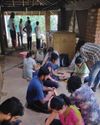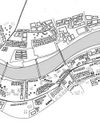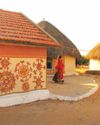Ayaz Basrai is a graduate from the National Institute of Design, Ahmedabad. Busride Design was launched by Ayaz Basrai along with his architect brother Zameer, a CEPT graduate. Busride has dabbled in designing Bollywood sets, miniature sets, exhibitions and kiosks, retail galleries, restaurants and boutique hotels, amongst built environments. They’ve also worked in the area of street art and graffiti, illustration, heritage conservation and urban planning; which Ayaz says, informs their practice in profound ways.
Speaking at the 361 degrees conference, Ayaz Basrai of Bandra-based The Busride Design Studio outlined the many inquiries and experiments the studio was engaged in. Describing the studio as a polyvalent entity that deals with a mixed bag of projects from sandcastles for Disney to more permanent ones like restaurants and bars, and retail stores, their success perhaps stems out of the giving up of coherence, and resigning to chaos. The studio is also informed by age-old ‘gyaan’ floating around all over Bandra; a church they pass by often has a sign that reads – No one ever moved forward while being chained to the past.
Designing for the future and the notion of time
With this as the starting point, the studio pursues a number of inquiries and experiments – mainly around the notion of time. In the most conventional sense, our idea of time is going on an upward projection from the past to the future, in a linear way. This is reinforced by western notions of science, our day to day experiences of reading clocks, etc. However, the Eastern notion of time is cyclical, as a constantly repeating loop, always in reoccurrence. This, he says, is really just the idea that everything that is happening right now, has happened in the past and is going to happen sometime in the future. This notion helps lay more responsibility for the maintenance of things we use, and the importance of creating closed loop economies.
Diese Geschichte stammt aus der May 2019-Ausgabe von Indian Architect & Builder.
Starten Sie Ihre 7-tägige kostenlose Testversion von Magzter GOLD, um auf Tausende kuratierte Premium-Storys sowie über 8.000 Zeitschriften und Zeitungen zuzugreifen.
Bereits Abonnent ? Anmelden
Diese Geschichte stammt aus der May 2019-Ausgabe von Indian Architect & Builder.
Starten Sie Ihre 7-tägige kostenlose Testversion von Magzter GOLD, um auf Tausende kuratierte Premium-Storys sowie über 8.000 Zeitschriften und Zeitungen zuzugreifen.
Bereits Abonnent? Anmelden

Interlacing Perspectives
‘Meraki-2019’ A visionary Seminar series presented by Dr.Baliram Hiray College of Architecture, Bandra(East), Mumbai.

Facilitating A Community Through Architectural Practice
The humble, self-designed, self-built and organically planned home built by the majority of the world population rarely gets appreciated and critiqued as a viable lesson in architectural design.

The Art Of Solving Problems Creatively
The practice of architecture is perhaps incomplete without the complement of a variety of other arts.

Upcycling towards a playful tomorrow
Play is like the middle child, often forgotten, and always taking a back seat. For young kids, play can simply be running around, armwrestling with friends, building sandcastles on the beach, or singing popular music tracks in the shower.

Balancing The Poetics And Pragmatism Of Everyday Design
Humanity is faced with an oxymoronic crisis. The crisis involves the earth, the environment, impending looms of climate change, deforestation, loss of species, dwindling resources etc.

Just Give Me Some Space: Discussions And Beyond
Just Give Me Some Space (JGMSS) is Suha Riyaz Khopatkar’s debut book that paints a portrait of the dynamic life of an architecture student.

The Next In Vernacular Architecture
Architecture has become a capitalist.

Rethinking The Future: Architecture And Its Education
“I want to be like animals, the bird makes a nest in one or two days, the rat digs a hole in a night, but intelligent humans like us spend 30 years to have a house, that’s wrong.” - Jon Jandai

Uniting The Human-Scale With The City-Scale
London-based architect Usman Haque is famed for his interactive architectural systems, and for his exploration of newer, more effective ways of creating human engagement and interaction through his designs. Indian Architect & Builder caught up with him, to quiz him on a variety of topics such as his journey as an architect, his inspirations and philosophies, architects using the digital revolution to their advantage, and more!

Framing spaces
Almost every architect also doubles as a photographer or at least an enthusiast.